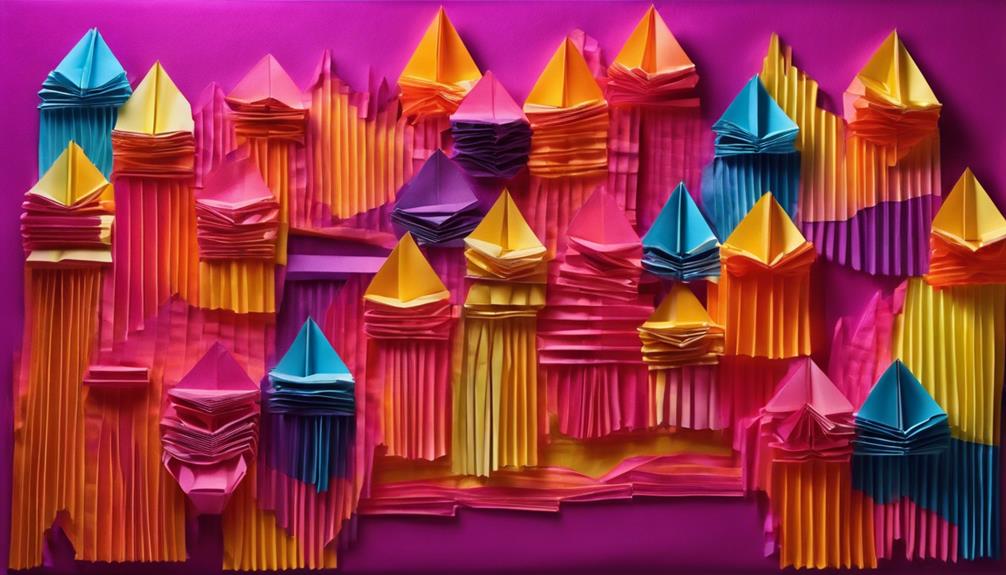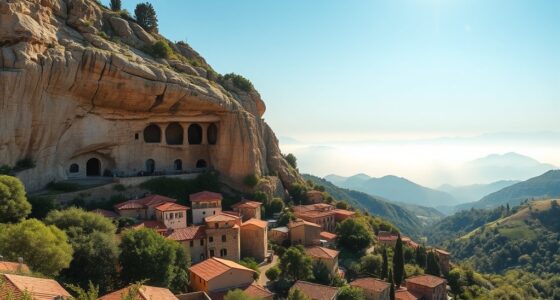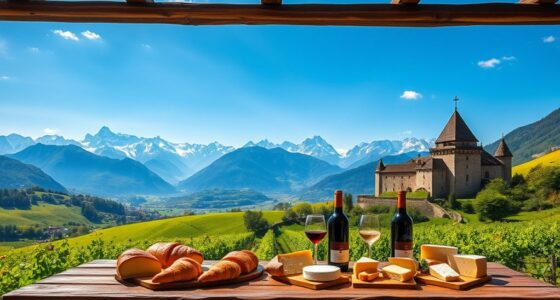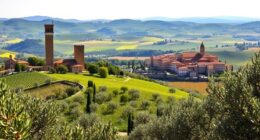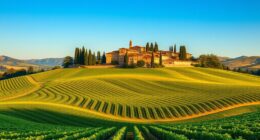In Florence's Renaissance period, marvel at masterpieces by Michelangelo, Da Vinci, Botticelli, Raphael, and Titian, showcasing rich heritage and creativity. Explore architectural wonders like Duomo Cathedral, Ponte Vecchio bridge, Palazzo Vecchio, Palazzo Pitti, and San Lorenzo Church designed by Brunelleschi and adorned by Donatello's sculptures. Visit Uffizi Gallery for iconic artworks and Academia Gallery for Michelangelo's David. Discover hidden gems at Chiostro dello Scalzo, Cenacolo di Sant'Apollonia, Ognissanti Church, and Cenacolo di Fuligno. Beyond Florence, explore Arezzo, Pisa, Stibbert Museum in Tuscany, and Bargello Museum. Each holds treasures waiting to be uncovered, revealing Italy's cultural and artistic heritage.
Key Takeaways
- Florence boasts hidden art gems like frescoes by Andrea del Sarto and Giotto.
- Explore works by Piero della Francesca in Arezzo and Benozzo Gozzoli in Pisa.
- Stibbert Museum in Tuscany offers lesser-known artistic wonders beyond Florence.
- Bargello Museum in Florence houses sculptures by renowned masters for art enthusiasts.
- Discover Italy's rich cultural and artistic heritage beyond Florence's iconic Renaissance treasures.
Artistic Marvels of Florence
Explore Florence's artistic marvels, from masterpieces by renowned artists to architectural gems showcasing the city's rich heritage. The Renaissance period in Florence was a time of unparalleled creativity and innovation, with artists like Michelangelo, Da Vinci, Botticelli, Raphael, and Titian leaving behind a legacy of breathtaking works.
Museums such as the Uffizi Gallery and Academia Gallery are veritable treasure troves of artistic brilliance, housing iconic pieces that have captivated art lovers for centuries. The Medici family, one of the most influential families in Florence during the Renaissance, played a pivotal role in patronizing these talented artists, contributing to the flourishing artistic scene of the city.
Hidden within the streets of Florence are architectural wonders that reflect the city's artistic prowess. The Duomo Cathedral, with its magnificent dome that was once the largest in the world, and the Ponte Vecchio bridge, lined with charming shops, are just a few examples of the architectural splendors that adorn Florence's landscape. These structures not only serve as indications of the city's rich heritage but also as reminders of the artistic ingenuity that defines Florence.
Iconic Architectural Wonders

Admire the iconic architectural wonders of Florence, each embodying the city's rich heritage and artistic ingenuity.
The Duomo Cathedral stands as a tribute to Renaissance art and architecture, boasting the world's largest dome during the 1400s, a marvel of architectural ingenuity and splendor.
Ponte Vecchio, the famed bridge, offers a picturesque view of the Arno River, known for its unique shops and historical significance.
Palazzo Vecchio, once the city's town hall, showcases impressive Renaissance architecture and artwork, a symbol of Florence's cultural richness.
The Uffizi Gallery houses a vast collection of Renaissance masterpieces, making it a must-visit for art enthusiasts.
Academia Gallery, home to Michelangelo's David, is a treasure trove of artistic wonders.
These architectural gems, along with other sites like the Palazzo Pitti and the San Lorenzo Church designed by Brunelleschi and adorned by sculptures of Donatello, reveal the artistic prowess of Florence and the genius of masters like Leonardo da Vinci and Michelangelo.
Masterpieces in Uffizi Gallery

The Uffizi Gallery in Florence boasts a collection of iconic artworks by renowned artists such as Botticelli, da Vinci, and Michelangelo.
As you explore the gallery, you'll have the opportunity to witness masterpieces like 'The Birth of Venus' and 'Tondo Doni', each showcasing the historical significance and artistic techniques of the Renaissance period.
The diverse array of over 2,200 works at the Uffizi Gallery offers a rich tapestry of artistic evolution, allowing you to immerse yourself in the legacy of Florence's cultural heritage.
Iconic Uffizi Artworks
Iconic masterpieces by renowned artists like Botticelli, Leonardo da Vinci, and Michelangelo await visitors at the Uffizi Gallery in Florence. The gallery is a treasure trove of Renaissance masterpieces, offering a deep insight into the artistic heritage of the era.
Some of the must-see artworks include:
- Botticelli's 'The Birth of Venus': A mesmerizing depiction of the goddess Venus emerging from the sea, symbolizing love and beauty.
- Botticelli's 'Primavera': A captivating painting representing the arrival of spring, adorned with mythological figures and lush vegetation.
- Leonardo da Vinci's 'Annunciation': A stunning portrayal of the Angel Gabriel announcing the conception of Jesus to the Virgin Mary, showcasing da Vinci's early genius.
- Michelangelo's 'Doni Tondo': A significant circular painting portraying the Holy Family, reflecting Michelangelo's mastery of form and emotion.
These artworks not only enchant the eye but also offer a profound cultural experience, inviting you to explore the artistic brilliance of the Renaissance period.
Historical Significance Highlighted
Explore the historical significance of the masterpieces housed in the Uffizi Gallery in Florence. The Uffizi Gallery stands as a tribute to the Renaissance treasures of Italy, showcasing priceless artworks by legendary artists like Leonardo da Vinci, Botticelli, and Michelangelo. Within its walls, visitors can witness iconic works such as Botticelli's 'The Birth of Venus' and Leonardo da Vinci's 'Annunciation', pieces that have become synonymous with artistic excellence.
With over 1,500 masterpieces on display, the Uffizi Gallery is revered as one of the most important art museums globally, drawing art enthusiasts and historians alike. Among the gallery's collection are Michelangelo's 'Doni Tondo' and Botticelli's 'Primavera', each contributing to the rich tapestry of Renaissance art history.
The historical significance of the Uffizi Gallery lies not only in its impressive array of masterpieces but also in its ability to inspire and captivate visitors, offering a glimpse into a bygone era of artistic brilliance.
Artistic Techniques Showcased
Within the walls of the Uffizi Gallery in Florence, explore an enchanting display of artistic techniques from the Renaissance period.
The Renaissance art techniques exhibited in the Uffizi Gallery's masterpieces offer a glimpse into the artistic evolution of that era. Witness how artists like Leonardo da Vinci and Botticelli skillfully utilized perspective in art, played with light and composition, and employed techniques such as sfumato to achieve a sense of depth and realism in their works.
Significantly, Botticelli's 'The Birth of Venus' stands out as a prime example of the intricate use of these techniques, engaging viewers with its beauty and symbolism.
As you wander through the gallery, you'll observe how the collection of Renaissance masterpieces reflects the diversity and innovation in artistic styles, showcasing a rich tapestry of creativity that continues to inspire art enthusiasts worldwide.
Michelangelo's David at Academia Gallery
Michelangelo's David at the Academia Gallery showcases the biblical hero in a powerful pose, symbolizing courage and defiance.
The sculpture's exquisite details, muscular form, and emotional intensity captivate viewers, highlighting Michelangelo's masterful sculpting skills.
Today, David's cultural impact remains significant, solidifying its status as a timeless masterpiece of Renaissance art.
David's Iconic Pose
With a gaze of determination and a pose exuding strength, Michelangelo's David stands tall at the Academia Gallery in Florence. This iconic statue, a true masterpiece of sculpture, captures the essence of bravery and beauty in its intricate details and lifelike representation of the biblical hero before facing Goliath.
As you stand before this symbol of Florence's artistic heritage and the Renaissance era, you can't help but feel a sense of awe and admiration for Michelangelo's skill and creativity. The way David's muscles tense, ready for battle, evokes a powerful emotion that resonates with viewers from all walks of life.
Here are some aspects of David's iconic pose that you may find intriguing:
- The intense expression on David's face conveys a mix of determination and focus.
- The positioning of David's body exudes a sense of readiness and confidence.
- The way David holds the slingshot highlights his strategic mindset and courage.
- The detailed anatomy of David's figure showcases Michelangelo's exceptional talent and attention to realism.
Sculpting Masterpiece Details
Crafted from a single block of Carrara marble, Michelangelo skillfully sculpted David at the Academia Gallery in Florence. Standing at an impressive 17 feet tall, this renowned sculpture represents the biblical hero David, poised before his legendary battle with Goliath. Michelangelo's meticulous attention to detail is evident in the lifelike human anatomy he expertly carved from the marble.
David's contrapposto pose, a hallmark of the High Renaissance period, adds a dynamic element to the statue, capturing a sense of movement and tension.
Completed between 1501 and 1504, Michelangelo's David has become a symbol of strength, beauty, and artistic mastery. Its unparalleled craftsmanship draws in millions of visitors to the Academia Gallery each year, showcasing the enduring impact of this masterpiece.
As one of the most celebrated sculptures in the world, Michelangelo's David continues to captivate audiences with its awe-inspiring presence and timeless elegance.
Cultural Impact Today
Explore how Michelangelo's David at the Academia Gallery continues to leave a lasting cultural impact today, drawing visitors from around the world to experience its significance firsthand. The renowned Renaissance sculpture offers a glimpse into the city's rich artistic and cultural heritage, providing a deeper understanding of Florence's hidden gems. When standing before Michelangelo's David, you can't help but feel a sense of awe and admiration for this authentic Florentine masterpiece. The statue's intricate details and symbolic representation of male beauty and strength resonate with visitors, transcending time to connect with modern audiences.
- Witnessing the sheer size and perfection of Michelangelo's David evokes a sense of wonder and amazement.
- The history and significance behind the sculpture offer a profound appreciation for Florence's artistic legacy.
- The Accademia Gallery provides a unique opportunity to immerse yourself in the art and history of the Renaissance period.
- Experiencing the David sculpture firsthand allows for a personal connection with one of the greatest masterpieces in the world.
Hidden Art Gems of Florence
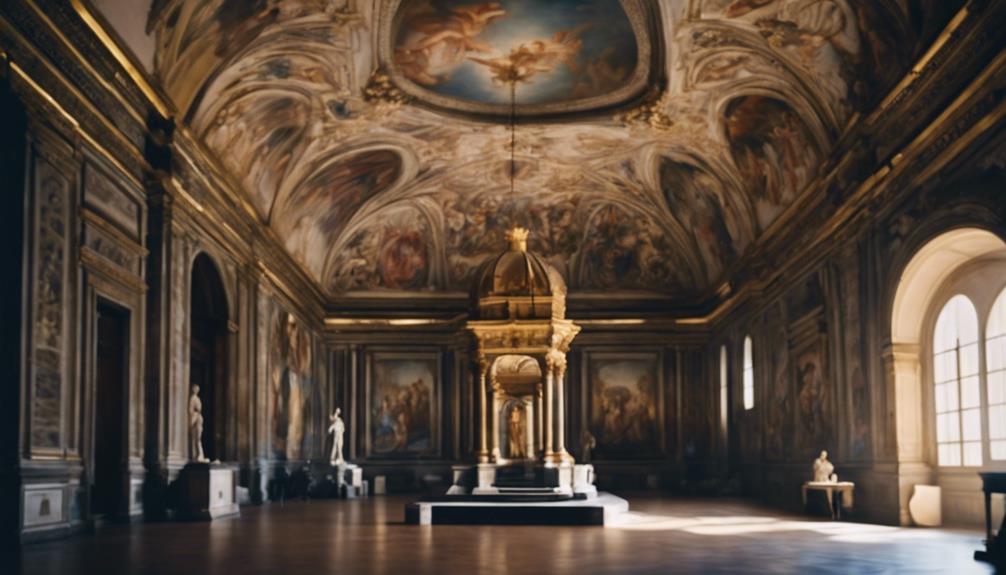
Uncover Florence's hidden art gems by delving into lesser-known masterpieces scattered throughout the city. Exploring these hidden art gems provides a unique insight into the rich Renaissance art heritage of Florence. From Andrea del Sarto's exquisite frescoes of the Last Supper to Andrea del Castagno's engaging work at Cenacolo di Sant'Apollonia, each piece offers a glimpse into the artistic brilliance of the era. These hidden treasures, often found in intimate settings, allow for a more personal and profound experience compared to the more famous artworks in the city.
To further illustrate the hidden art gems of Florence, consider the table below:
| Location | Artwork |
|---|---|
| Chiostro dello Scalzo | Frescoes by Andrea del Sarto |
| Cenacolo di Sant'Apollonia | Last Supper fresco by Andrea del Castagno |
| Ognissanti Church | Last Supper painting by Giotto and Botticelli |
| Cenacolo di Fuligno | Pietro Perugino's Last Supper fresco |
Renaissance Treasures Beyond Florence

Discover Renaissance treasures beyond Florence in various towns and museums across Tuscany, each offering a unique glimpse into Italy's artistic heritage.
- Arezzo: Immerse yourself in the Renaissance art allure of Arezzo, where works by Piero della Francesca captivate visitors with their beauty and historical significance.
- Pisa: Explore the Camposanto Monumentale in Pisa, adorned with frescoes by renowned artists like Benozzo Gozzoli, providing insights into the rich artistic heritage of the region.
- Stibbert Museum: Uncover hidden gems at the Stibbert Museum and Garden in Tuscany, where a treasure trove of artistic wonders awaits, offering a unique perspective on Italy's cultural legacy.
- Bargello Museum: Explore the sanctuary of Renaissance art at the Bargello Museum in Florence, home to exquisite sculptures by masters like Michelangelo, Donatello, and Cellini, showcasing the pinnacle of artistic craftsmanship.
Frequently Asked Questions
What Was Florence Known for in the Renaissance?
During the Renaissance, Florence was renowned for being a center of artistic innovation and creativity.
The city attracted famous artists like Leonardo da Vinci, Michelangelo, and Botticelli, who contributed to its flourishing art scene.
Supported by the influential Medici family, Florence became a hub for masterpieces such as Michelangelo's David and Botticelli's Birth of Venus.
Iconic works from this period are housed in the Uffizi Gallery and Accademia Gallery in Florence.
What Was Florence Source of Wealth During the Renaissance?
During the Renaissance, Florence's source of wealth stemmed from a thriving textile industry, especially silk and wool production.
The city's banking sector, led by influential families like the Medici, also played a significant role.
Florence's strategic position as a trading hub in Europe facilitated the exchange of goods and ideas, while skilled artisans and craftsmen contributed to the city's economic success.
Patronage of the arts by wealthy families further fueled Florence's cultural and economic growth.
What Are Three Famous Pieces of Art That One Could Find in the City of Florence?
In Florence, you can discover Michelangelo's David at the Accademia Gallery, Botticelli's Birth of Venus at the Uffizi Gallery, and works by Raphael and Titian at the Palazzo Pitti.
Each piece showcases the pinnacle of Renaissance artistry, drawing visitors from around the world to admire these timeless masterpieces.
These renowned artworks, among many others in Florence, offer a glimpse into the rich artistic heritage of the city during the Renaissance era.
What Was Florence's Main Export During the Renaissance?
During the Renaissance, Florence's main export was luxury goods, specifically high-quality textiles such as silk and wool. The city's intricate and beautifully crafted fabrics were in high demand among the wealthy elite across Europe.
Skilled artisans and the patronage of influential families like the Medici contributed to the thriving textile industry in Florence. These textiles were prized for their exquisite designs, vibrant colors, and superior materials, distinguishing them in the European market.
Conclusion
So, next time you find yourself in Florence, be sure to explore the city's renaissance treasures. From iconic architectural wonders to hidden art gems, there's no shortage of artistic marvels to admire.
Whether you're visiting the Uffizi Gallery or marveling at Michelangelo's David at the Academia Gallery, you'll be surrounded by centuries of creativity and craftsmanship.
And remember, the renaissance treasures of Florence extend beyond the city limits, waiting to be discovered by the curious traveler.


